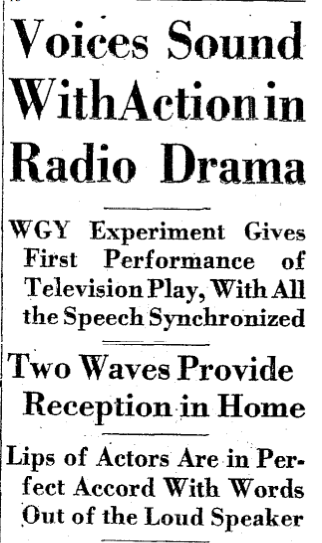
Buried in the details of the first longish-distance transmission of television into a home (albeit the home of its creator, Dr. E.F.W. Alexanderson) is the little matter of how the sound was transmitted. The earliest experiments in transmitting motion pictures were focused on the pictures; since we already knew how to send sound over the airwaves, the audio was sent by a separate radio broadcast.
Just a few months after that first transmission came the first performance of a “radio television drama.” On September 11, 1928, WGY sent a signal “in which the faces and some of the movements of the actors were transmitted by television on one wave length while the words were broadcast on another wave length.”
“On two adjacent receiving sets, one a special television receiver, the other a familiar loudspeaker operating set, the small television images and the spoken lines were reproduced at a point three miles from the sending station, creating an acoustically accurate and visually blurry radio talking motion picture of J. Hartley Manners’s one-act drama, ‘The Queen’s Messenger.'” (Amazingly, there’s an IMDB listing for it.) This was the first attempt to match a television and a radio signal, and the first attempt to “combine the new television and the familiar radio word-drama into a dramatic performance for home consumption.”
At this point it goes without saying that this experiment occurred in Schenectady, does it not?
“By using three of the simplified television cameras and the regular studio microphones the faces of the hero and heroine of ‘The Queen’s Messenger’ could be televised as they uttered their proper lines in the studio, and television images of important movements, such as revolver brandishings and cocktail pouring, also could be presented.” Screen size had vastly improved from January of that year, with the images being shown on a three-inch by three-inch screen, “permitting the projection of ‘close ups’ of the actor and actress, one after another, and reproductions of photographs of persons to whom they had to refer in the course of the play.”
Happily, the names of those first thespians to fill the airwaves were recorded. The heroine was Miss Izetta Jewel, who was a well-known stage actress, women’s rights advocate and politician. The hero was played by Maurice Randall, who appears not to have been as well-remembered. The director of the drama was Mortimer Stewart. And in the interest of accuracy, we must note that the actual title of the play was “A Queen’s Messenger,” and this somewhat historic drama is available online. The revolver is brandished on page 24.
